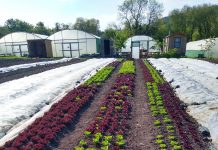December is a great month to treat yourself by sitting in your comfiest chair with a cup of tea and sifting through the pages of seed catalogues to give you some inspiration for next year. It is the time that we like to finish up all of our crop planning for next season, tweaking this year’s plans with the notes that we have made throughout the year. By having a solid plan and following a good rotation we can make sure that we can produce as much as possible from a small space. As with all good plans we often have to change things around a bit throughout the year, but at least we have a rough idea of what should be going where and how much of each crop we intend to grow. This then feeds into our sowing plan for the year and gives us a list of what seeds we need to order.
Some seeds last a fairly long time if stored well (cool, dry conditions – ideally in an airtight container) such as beans, peas, tomatoes and brassicas, whilst the longevity of others such as parsnips, parsley (in fact most of the umbellifer family) along with many of the alliums like spring onions and shallots, is far shorter. With this in mind you can order more than you need of certain vegetable seeds, and make sure that you only order enough for one season of others.
We have a few favourites that we grow each year, but we always like to try out different varieties to add diversity to what we grow and to keep it interesting. It is well worth looking at seed catalogues that you have never tried before rather than just relying on the ones that you have been using for years. This will not only highlight varieties that you may not have otherwise tried, but also if you select small independent seed companies that produce seed in the UK you will be choosing varieties that grow especially well in our climate. Some seed catalogues that I strongly recommend are Real Seeds, The Seed Cooperative, Vital Seeds and Beans & Herbs. All of these seed companies sell only open pollinated seed varieties so that you can save the seed yourself once you have tried it out (they even give you details of how to save the seed!). They also sell lots of varieties that you won’t find in the normal seed catalogues and in buying from them – you are supporting the really important work that they are doing to preserve some of the older varieties that would otherwise be lost. This means that more diversity is maintained (by growing more varieties we are keeping a wider gene pool), which then gives us more resilience to everything that climate change presents to us. Just 10 companies own around two thirds of the seed that is available across the world. We are in a pretty dire state when it comes to the decline in biodiversity, and anything to support businesses that are doing what they can to maintain some of the more unusual and older varieties is really helpful.
WHAT TO SOW THIS MONTH: Best to wait until next year now!
WHAT TO PLANT THIS MONTH:
OUTSIDE: Garlic (if not planted already)
INSIDE: peashoots, sugarsnap and early pea varieties, spring onions, broad beans, garlic (for extra early garlic). Try and plant all of this early in the month.
OTHER IMPORTANT TASKS THIS MONTH: If the weather dries, continue preparing beds for the winter by mulching with compost, but otherwise take the opportunity to take it a bit easier.








